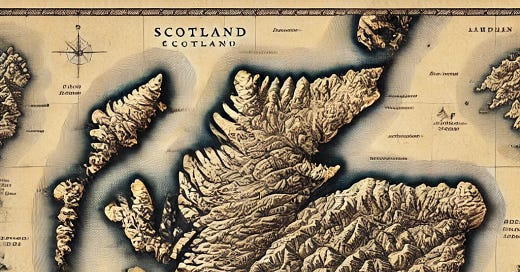The Significance of Drumalban: A Key Boundary in Ancient Scotland
The history of the Scottish Highlands is rich with intricate details and geographical nuances that shaped the lives and boundaries of its early inhabitants. One such significant geographical feature is Drumalban, a mountain ridge that played a crucial role in dividing the territories of the Picts and the Scots. This blog post delves into the importance of Drumalban, tracing its historical significance and the role it played in the territorial delineations of ancient Scotland.
Drumalban: The Backbone of the Highlands
Drumalban, often referred to as the dorsum Britanniae (the backbone of Britain), is not just a physical barrier but a symbolic one that separated distinct cultures and peoples in early Scottish history. According to historical sources, including the writings of William F. Skene, Drumalban served as the western boundary of the Picts, a Celtic people who inhabited Scotland before and during the early medieval period.
Defining Boundaries
The Picts occupied a vast territory extending from the Firth of Forth in the south to the Pentland Firth in the north, and from the North Sea in the east to the mountainous ridge of Drumalban in the west. This boundary was critical in delineating Pictish land from that of the Dalriadic Scots, an Irish colony that settled in what is now Argyll and Bute.
Skene's detailed research highlights that Drumalban effectively separated the "provincia Pictorum" (Pictish province) from the Scots, who had their own defined regions such as Lorn, Argyll Proper, and Kintyre. This separation was not just geographical but also cultural and political, helping to maintain distinct identities between these two groups.
The ridge of Drumalban runs from Loch Long in the south to the Linne Loch in the north, creating a natural barrier that influenced the development of the territories on either side. The Scots of Dalriada occupied the western side of this ridge, while the Picts held the lands to the east and north. This geographical feature not only served as a defensive boundary but also as a defining marker in the identities of the two peoples.
The Role of Drumalban in Historical Narratives
Several historical documents and chronicles make references to Drumalban, emphasizing its importance. For instance, Adomnan, in his "Life of St. Columba," frequently mentions that St. Columba traveled "ultra dorsum Britanniae" (beyond the back of Britain) to reach the Pictish territories. This phrase underlines Drumalban's role as a significant divider between the lands of the Scots and the Picts.
Furthermore, Tighernac's annals and other early medieval sources consistently mention Drumalban when describing territorial disputes, battles, and political boundaries. This consistency across various sources indicates that Drumalban was a well-recognized and respected boundary in ancient Scotland.
The historical references to Drumalban also highlight its role during key events and transitions in Scottish history. For example, during the seventh and eighth centuries, as the Picts and Scots engaged in various conflicts and alliances, Drumalban often served as a strategic line of defense or a point of contention. Its rugged terrain made it a natural fortification, influencing military strategies and territorial negotiations.
The Transition of Power and Cultural Exchange
While Drumalban was a significant boundary, it was also a place where cultural exchanges occurred. The proximity of the Scots and Picts allowed for interactions that influenced the development of early Scottish society. The Picts, known for their unique art and societal structures, and the Scots, with their rich Gaelic traditions, both contributed to the cultural mosaic of the region.
The importance of Drumalban persisted through the centuries, even as the political landscape changed. By the time of the Scottish conquest in the ninth century, which unified various tribes under a single monarch, Drumalban remained a crucial geographical reference point.
The cultural exchanges across Drumalban likely included trade, intermarriage, and shared religious practices. These interactions would have facilitated the blending of traditions and customs, contributing to a more cohesive Scottish identity over time. The spread of Christianity, in particular, played a significant role in bridging the cultural divide, with missionaries like St. Columba working among both the Picts and Scots.
Modern Reflections on Drumalban's Legacy
Today, Drumalban's legacy can still be felt in the landscape and cultural heritage of Scotland. The ridge, though not as prominently named in modern geography, remains a symbolic reminder of the ancient divisions and connections that shaped the nation. Hiking along the remnants of this historic boundary, one can imagine the lives of the early Scots and Picts, whose identities were so deeply intertwined with the land.
The study of Drumalban and its historical significance also provides valuable insights for modern historians and archaeologists. By understanding the geographical features that influenced ancient boundaries, researchers can better interpret the archaeological sites and historical records that tell the story of Scotland's past.
Conclusion
Drumalban's significance in Scottish history cannot be overstated. As a natural boundary, it shaped the territorial and cultural landscape of ancient Scotland, separating the Picts and the Scots and influencing their interactions. Understanding the role of Drumalban provides deeper insights into the complexities of early Scottish history and the development of its unique cultural identity.
By appreciating such geographical features, we gain a better understanding of the historical narratives that have shaped Scotland. Drumalban stands as a testament to the intricate relationship between geography and history in the Highlander's story. Its enduring legacy invites us to explore and reflect on the past, connecting the ancient world with our present understanding of Scottish heritage.





